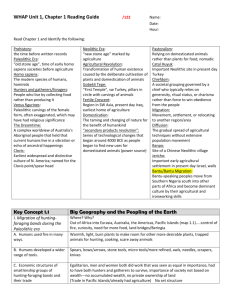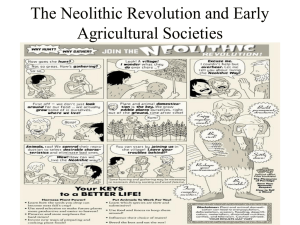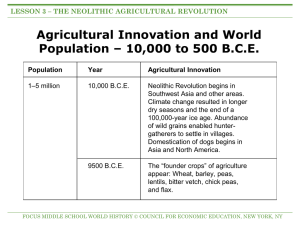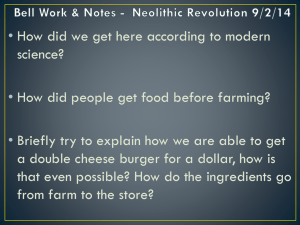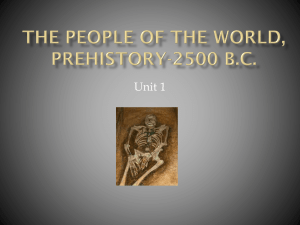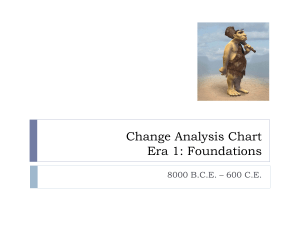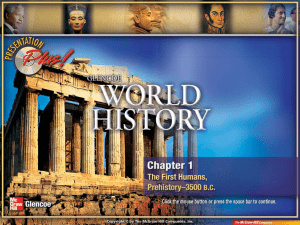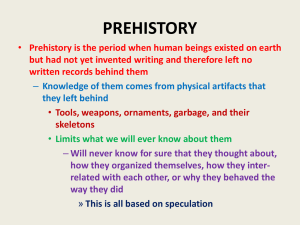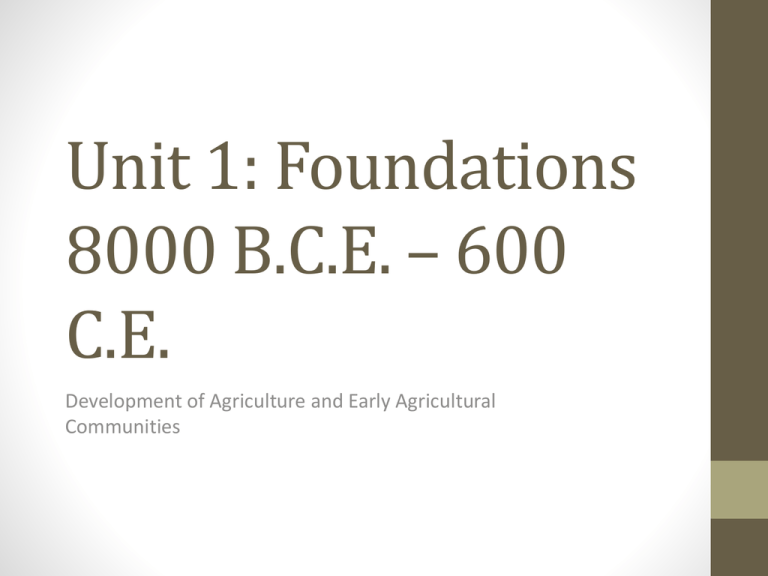
Unit 1: Foundations
8000 B.C.E. – 600
C.E.
Development of Agriculture and Early Agricultural
Communities
Foundations
Understanding these things will make your life easier
Vocabulary You Need
•
•
•
•
•
•
•
•
Cultural diffusion
Demography
Intervening obstacles
“Marker events”
Migrations
Periodization
Perspective
Push and pull factors
B.C.E, C.E.? What?
• B.C.E. = Before Common Era, replaced B.C.
• C.E. = Common Era, replaced A.D.
• In B.C.E, the bigger the numbers, the longer ago is
happened
• In CE, the bigger the numbers, the sooner it happened
8000
B.C.E
7000
B.C.E.
100
B.C.E
1000
C.E.
• Example: 8000 B.C.E. happened before 100 C.E.
• 2000 C.E. happened AFTER 100 C.E.
2000
C.E.
Centuries
• When is the 17th century?
• 1601-1699
• To figure out what years a century is talking about:
• 1. Take the century subtract 1
• Ex: 17th century
• 17-1 = 16
• So 17th century = 1600’s
• 2. Take the year and add 100 (ignore anything past the first two
numbers)
• Ex: 1810
• 1810+100 = 1910
• So, 1800s = 19th century
Primary Sources vs. Secondary
Sources
• Primary sources – original evidence from a time period
• ORIGINAL DOCUMENTS (excerpts or translations acceptable):
Diaries, speeches, manuscripts, letters, interviews, news film
footage, autobiographies, official records
• CREATIVE WORKS: Poetry, drama, novels, music, art
• RELICS OR ARTIFACTS: Pottery, furniture, clothing, buildings
• Ex: Diary of Anne Frank, Constitution of the US, weavings and
pottery, journal article reporting NEW research and findings
Primary Sources vs. Secondary
Sources
• A secondary source interprets and analyzes primary sources.
• Secondary sources may have pictures, quotes or graphics of
primary sources in them.
• Some types of secondary sources include: PUBLICATIONS:
Textbooks, magazine articles, histories, criticisms,
commentaries, encyclopedias
• Ex:
• A journal/magazine article which interprets or reviews previous
findings
• A history textbook
• A book about the effects of WWI
Geography, The Physical
Environment, and You
• Change in borers and civilizations are constant
• Physically, world of 4000 B.C.E. looks similar to our world
today
• Geographical history moves slower than political
• Before we began transforming landscapes, physical geography
shaped and limited activities
Geography, The Physical
Environment, and You
• Perspective or point of view
• We all see our surroundings through the lens of our own time
period and culture
• People have been making cultural distinctions for years, we have
to adjust our cultural perspectives as we go through time,
realizing cultural meanings from one era impact those of later
eras and that change has been continual
Demography
• Demography = study of population
• Changes in population are important part of how the human
story has shape
• Population increases and decreases have caused people to
move, bringing other ways of life and causing political, social,
and economic changes
Migrations
• Permanent moves to new locations
• Occur on local, regional, and global levels
• Push factor = encourages people to move from the region they live in
• Ex: persecution
• Pull factor = attracts people to a new region
• Ex: better jobs, more democratic govt
• Environmental factors:
• Intervening obstacles or physical features that halt or slow migration
• Over time, they may have different meanings
•
Ex: Ocean no longer prevents migration once new technology to cross is develops
Cultural Diffusion
• When people move, bring culture with them
• Cultural diffusion
• Includes innovations, technology, religion, language food, clothing
styles, disease
• Diseases have spread as human interactions have increased
• 14th century plague, contagious diseases with the Native Americans
• Cannot pin historical migrations to a single “marker event”
because they took place gradually over long period of times
• Without them, humans might not have survived the early
years
Agricultural
Development and
Early Agricultural
Communities
Vocabulary You Need
•
•
•
•
•
•
•
•
Agriculture
Bipedalism
Catal Hayuk
Cultural diffusion
Division of labor
Horticulture
Independent invention
Jericho
• Lucy
• “Marker events” of
pre-history
• Neolithic craft
industries
• Neolithic Revolution
• Paleolithic Age
• Pastoralism
• Polytheism
• Specialization
• Surplus
When is history?
• History usually defined as study of past beginning with first
systematic written records in the 4th millennium (4000-3000
B.C.E.)
• Important developments before this that influenced course of
world history
• “Marker Event” – development of agriculture and
agricultural communities
Human Life Before 8000
B.C.E.
• Humans existed for millions of years by 8000 B.C.E.
• Archaeologists (scientists who study prehistoric and ancient
peoples) believe the decisive differentiation between
humans and apes occurred between 6-8 million yeas ago
• Bipedalism (preference for walking erect on two limbs other
than four) make us distinct from other mammals
Human Life Before 8000 B.C.E.
• Earliest bipedal
creature –
Ardepithecus ramidus
found in Ethiopia in
2001
• All other human
species died out
except homo sapiens
• Surviving human species
between 50,000-10,000
years ago
Human Life Before 8000 B.C.E.
• Primary sources
during this period are
objects, artifacts, and
skeletal remains
• Hominids used refined
tools 70,000 years ago
during the Paleolithic
Age (Old Stone Age)
• Lasted until about 8000
B.C.E.
• Humans inhabited all
continents except
Antarctica
Human Life Before 8000 B.C.E.
• Homo sapiens had
many advantages
• Forelimbs free from
walking
• Opposable thumbs
• A large brain
• Not as strong as other
species but figured
out how to survive
Hunting and Gathering
• During Paleolithic Age, humans survived by foraging for food
–
• Hunting for animals
• Gathering edible plants
• Traveled in small groups (30-50)
• Nomadic – constantly moving to follow animals and find new
edible plants
• Kept people from accumulating possessions or claiming
property ownership
Hunting and Gathering
• Division of labor based on sex
• Men hunt
• Women gather
• No evidence one was considered more important than the other
• Survival depended on understanding of environment
• Older women had extensive knowledge of plants and passed
skills to younger women
• Hunters had to make clever traps and figure out ways to hunt
animals larger than them
Importance Of Tools
• Early tools made of:
• Wood
• Bone
• Stone
• Few survive today
• Tools used to help
build huts and
eventually to weave
cloth.
• Allowed them to
invent and sustain
agriculture
Paleolithic Culture
• Little is known because of
few surviving artifacts
• Cave paintings in North
Africa, oldest from 32,000
years ago
• Some paintings indicate they
had well-developed religion
• Careful, ritualistic burials
• In areas with abundant
resources, humans probably
only spent 3-5 hours tending
to their survival
• Rest of time used to make
tools, create art, and socialize
Neolithic Revolution
• Marker event – 8000 B.C.E.
(roughly)
• Neolithic (New Stone Age)
Revolution
• Agricultural Revolution
• Not a single event, occurred
at different times in different
parts of the world
• Took several generations to
truly take hold
• Agriculture
• Deliberate tending of crops
and livestock in order to
produce food and fiber
• Adopted originally to
supplement needs
Early Horticulture and
Pastoralism
• Horticulture used only hand tools such as hoes and digging sticks
• Pastoralists first domestication of animals but remained seminomadic
• Horticulturists first to settle in one place and eventually integrated
domestication of animals
• Agriculturalists could cultivate larger fields and plows turned soil to
increase fertility
• Communities grew larger as surpluses grew
Domestication of Grains
• Middle East has earliest evidence of agriculture
• Development of agriculture dependent on availability of
grains and animals that could be domesticated in the area
• Availability of food may have sped up the process
• Food scarce, develop agriculture as an alternative
• Plants in Middle East spread through cultural diffusion
• People learned from those already farming
• Agriculture developed as an independent invention
• (No cultural diffusion)
• Domesticated rice in China, maize in Mesoamerica, potatoes,
squash, tomatoes, and peppers in Peru
Domestication of Animals
• As people settled down, trained animals to stay put, too
• Some more easily domesticated than others
• Dogs were probably first
• More directly related to development of agriculture:
•
•
•
•
•
•
•
Domestication of sheep and goats in SW Asia
Cows in Eurasia and N. Africa
Water buffalo and chickens in China
Camels in Arabia and central Asia
Horses and pigs in Eurasa
Llamas in the Andes
Mesoamerica, Sub-Saharan Africa, New Guinea, and Andes had
few good animal candidates
Neolithic Revolution as a Marker
Event
• Changes to the way human beings lived:
•
•
•
•
•
•
People settled down
Division of labor
Social inequality
Gender inequality
Importance of surplus
Religious changes
People Settled Down
• To be near crops, humans settled into villages
• Didn’t have to worry about carrying possessions, so started to
accumulate goods
• Began to claim land as their own
• Private property began to define human society
Division of Labor
• Basic division in hunter/gatherer:
• Men hunt
• Women gather
• People started to see advantages of “specialization”
• All work could be done more efficiently
Social Inequality
• Hunter/gatherer groups usually had relative social equality
• Agricultural societies had social distinctions, eventually
evolving into social classes
• People with more land than others passed it to their children
• Some families more “distinguished” than others
• Some specializations awarded more respect or material
awards
• Social inequality increased
Gender Inequality
• Neolithic Revolution beginning of status distinctions
between men and women
• Women lost economic power in agricultural societies
• Men took over animals and crops, women sent to domestic
chores no longer needed for survival
Importance of Surplus
• Not everyone a farmer anymore
• Farmer had to produce a surplus to support him and his
family and others in village
• Food could be put away for bad periods
• Health improved, population increased, more specialization
occurred, villages grew
• Eventually grew to cities that needed specialized jobs in
government
Religious Changes
• Most agricultural societies developed polytheism
• Belief in many gods
• “gods” with human characteristics presided over areas
important to farmers
• Sun gods, rain gods, gods of the harvest, female fertility gods
Three Craft Industries
• Three craft industries developed as result of Neolithic
Revolution:
• Pottery
• Containers for sharing foods, waterproof
• Made by fire-hardening clay
• Metallurgy
• Copper probably first metal humans shaped into tools and jewelry
• By 6000 B.C.E. discovered they could heat to high temperatures and
fashioned knives, farm tools, and weapons
• Textiles
• People wove fibers as early as 6000 B.C.E.
• Eventually spun spread and wove into cloth
Growth of Towns and Cities
• By 4000 B.C.E., villages had grown into towns, and towns into
small cities
• Jericho on the Jordan River
• Catal Huyuk in southern Turkey
• Both heavily fortified for protection
• Jericho’s houses were surrounded by a ditch and wall almost 12 ft
high
• Catal Huyuk’s houses were joined together so outside entrances
were barricaded and houses could not be invaded
• Both relied on trade
• Foreshadowing of great civilizations and cities of 4th
millennium B.C.E.

